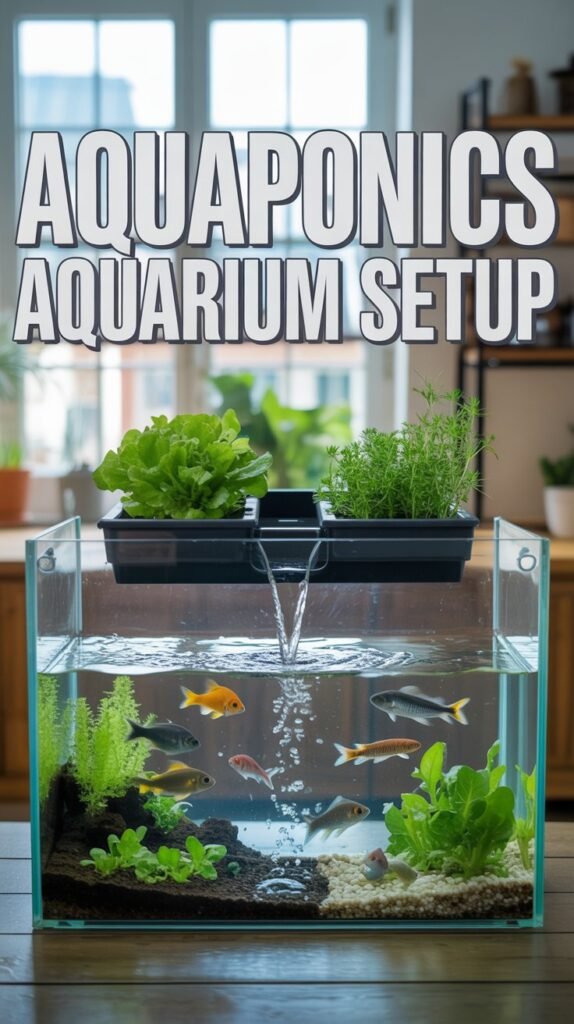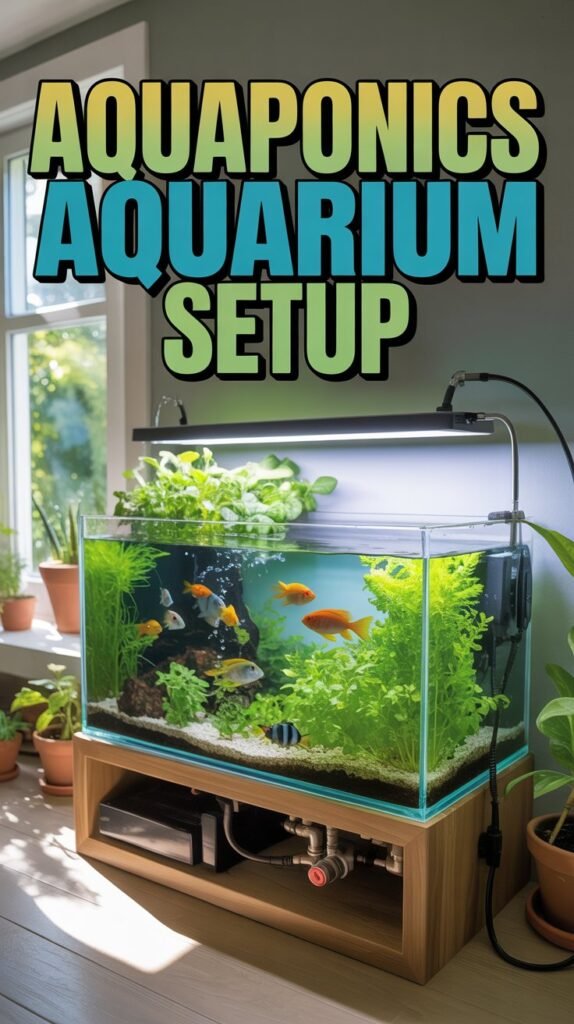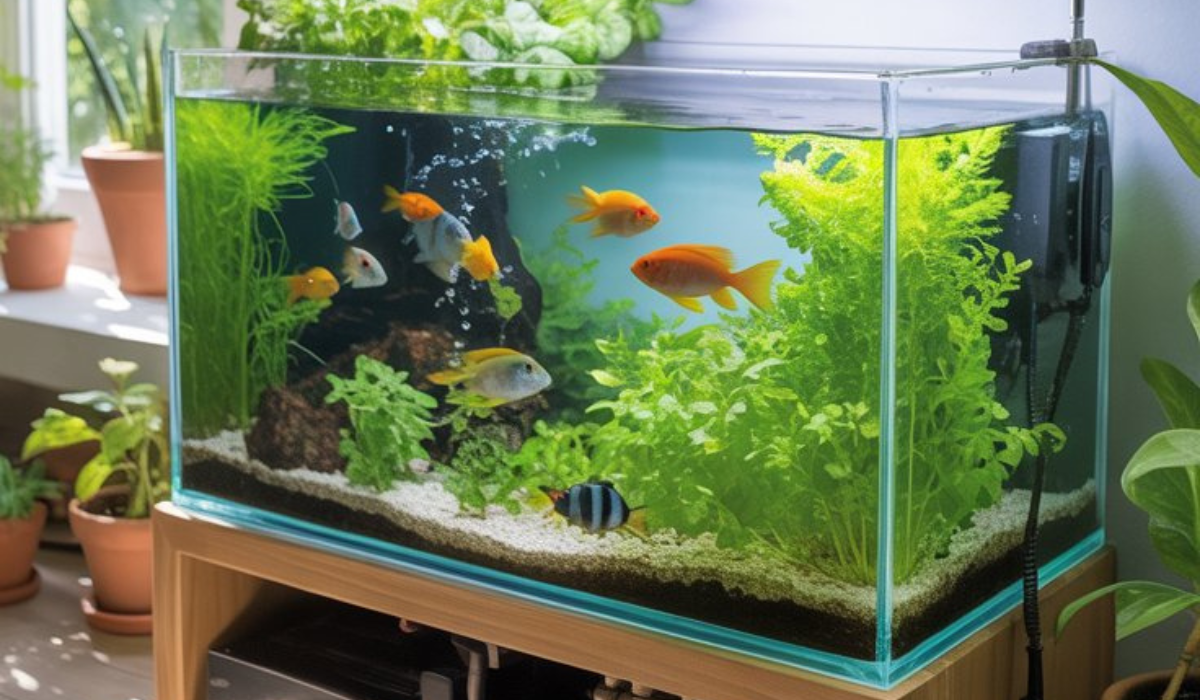Aquaponics is an exciting and eco-friendly way to combine fishkeeping and plant growing into one self-sustaining system. In an aquaponics aquarium setup, fish and plants work together in harmony—the fish provide nutrients for the plants, and the plants help filter and purify the water for the fish. It’s a perfect blend of aquaculture (raising fish) and hydroponics (growing plants in water).
If you’ve ever dreamed of having a system where your aquarium not only looks beautiful but also produces healthy plants, aquaponics is the way to go. In this comprehensive guide, we’ll cover everything you need to know about aquaponics aquarium setups—how they work, their components, setup process, maintenance tips, and much more.
What Is an Aquaponics Aquarium?
An aquaponics aquarium is a closed-loop ecosystem that combines fish, beneficial bacteria, and plants. The fish waste provides nutrients for the plants, while the plants clean the water by absorbing those nutrients.
Here’s how it works in simple terms:
- Fish eat and produce waste.
- The waste breaks down into ammonia, which is toxic to fish.
- Beneficial bacteria convert ammonia into nitrates, which are safe and beneficial for plants.
- Plants absorb the nitrates as nutrients, purifying the water.
- Clean water flows back to the aquarium, completing the cycle.
This process is called the nitrogen cycle, and it’s the foundation of a successful aquaponics system.
Why Choose an Aquaponics Aquarium Setup?

An aquaponics system offers numerous benefits that make it ideal for both hobbyists and eco-conscious individuals.
1. Natural Filtration System
Plants naturally filter the water by absorbing harmful compounds like ammonia and nitrates, reducing the need for mechanical filters.
2. Sustainable and Eco-Friendly
Aquaponics reduces water waste since the same water circulates through the system. It’s an environmentally friendly approach to fishkeeping and gardening.
3. Dual Purpose – Fish and Plants
You can raise beautiful aquarium fish while also growing herbs, vegetables, or ornamental plants—all in one setup.
4. Healthier Fish and Plants
The symbiotic relationship ensures your fish live in clean, balanced water, while plants receive a constant supply of organic nutrients.
5. Low Maintenance
Once established, an aquaponics system requires less frequent cleaning and fewer water changes than a traditional aquarium.
Key Components of an Aquaponics Aquarium Setup
Before starting, it’s important to understand the essential parts that make an aquaponics system work smoothly.
1. Fish Tank
The fish tank is the base of your aquaponics system. It’s where your fish live and produce waste that fuels plant growth.
Tips for Choosing a Tank:
- Glass or acrylic tanks both work well.
- A 20 to 50-gallon tank is ideal for beginners.
- Ensure it’s large enough for your chosen fish species.
2. Grow Bed
The grow bed is where your plants are placed. It sits above or beside the fish tank and holds the plants and growing medium.
Common Materials for Grow Beds:
- Plastic containers
- Acrylic trays
- Custom-made hydroponic planters
Growing Media Options:
- Expanded clay pebbles (Hydroton)
- Lava rocks
- Gravel
- Coconut coir
These materials provide stability for plants and promote bacterial growth.
3. Water Pump
A pump circulates water from the fish tank to the grow bed and back again. It’s the heart of the aquaponics system, ensuring the nitrogen cycle continues smoothly.
Tip: Choose a submersible pump with adjustable flow for better control.
4. Grow Lights
If your setup is indoors or lacks sunlight, LED grow lights provide the necessary light spectrum for plant photosynthesis.
5. Air Pump
An air pump increases oxygen levels for both fish and beneficial bacteria, improving overall system health.
6. Plumbing System
This includes tubes, pipes, and fittings that transport water between the tank and the grow bed. PVC pipes are most commonly used due to their durability and affordability.
7. Beneficial Bacteria
Bacteria play a crucial role in converting fish waste (ammonia) into nitrates. Without these microorganisms, your aquaponics system won’t function properly.
8. Plants and Fish
The living elements—plants and fish—are the stars of the system. Choosing compatible species is key to success, which we’ll cover next.
Best Fish for Aquaponics Aquarium Setup

Not all fish are ideal for aquaponics. Choose hardy species that produce enough waste to nourish your plants and can tolerate various water conditions.
1. Guppies
- Hardy and colorful
- Easy to breed
- Great for small systems
2. Tilapia
- Fast-growing
- High waste producers (good for plant growth)
- Prefer warmer water
3. Goldfish
- Ideal for beginners
- Produce ample waste
- Adaptable to different water temperatures
4. Betta Fish
- Suitable for small desktop aquaponics tanks
- Require minimal maintenance
5. Koi
- Excellent for outdoor systems
- Long lifespan and high waste output
6. Mollies and Platies
- Peaceful community fish
- Thrive in various environments
Tip: Avoid predatory or large fish that may disturb the ecosystem balance.
Best Plants for Aquaponics Aquarium
Plants thrive in nutrient-rich water from fish waste. Here are some top choices:
1. Herbs
- Basil
- Mint
- Parsley
- Cilantro
2. Vegetables
- Lettuce
- Spinach
- Kale
- Cherry tomatoes
3. Decorative Plants
- Peace lilies
- Pothos
- Lucky bamboo
Tip: Start with fast-growing plants—they absorb more nutrients and stabilize your system faster.
Setting Up an Aquaponics Aquarium – Step-by-Step
Now that you understand the components, let’s go through the process of setting up your aquaponics aquarium.
Step 1: Choose Your Location
Select a stable and well-lit area for your setup. Avoid direct sunlight that may cause algae growth or temperature fluctuations.
Step 2: Install the Fish Tank
Place your tank on a sturdy surface. Ensure it’s level and has access to power outlets for pumps and lights.
Step 3: Set Up the Grow Bed
Position the grow bed above or beside the fish tank. The grow bed should allow water to flow freely back into the tank.
Step 4: Add the Pump and Plumbing
- Connect the water pump to send water from the tank to the grow bed.
- Use return pipes for the water to flow back.
- Make sure all connections are watertight.
Step 5: Add Growing Media
Fill your grow bed with chosen media (e.g., clay pebbles). Rinse them thoroughly before adding to remove dust and debris.
Step 6: Start Cycling the System
Before adding fish, cycle your aquarium to establish beneficial bacteria.
Fishless Cycling:
- Add ammonia manually or use fish food to start the process.
- Test water regularly for ammonia, nitrite, and nitrate levels.
- Once nitrates appear and ammonia/nitrite drop to zero, the cycle is complete.
This process usually takes 3–4 weeks.
Step 7: Add Fish
Once the nitrogen cycle is established, add your fish gradually. Avoid overstocking in the beginning.
Step 8: Add Plants
Place plants in the grow bed. Ensure their roots touch the nutrient-rich water for optimal growth.
Step 9: Monitor and Adjust
Test water parameters weekly for:
- Ammonia
- Nitrite
- Nitrate
- pH
- Temperature
Maintain balance to keep both fish and plants healthy.
How the Nitrogen Cycle Works in Aquaponics

The nitrogen cycle is vital for a successful aquaponics aquarium:
- Fish produce waste, which releases ammonia.
- Bacteria (Nitrosomonas) convert ammonia into nitrites.
- Another bacteria group (Nitrobacter) converts nitrites into nitrates.
- Plants absorb nitrates, using them as nutrients for growth.
- Clean water returns to the fish tank, completing the loop.
This natural cycle creates a balanced, sustainable ecosystem.
Maintenance Tips for Aquaponics Aquarium Setup
Even though aquaponics is low-maintenance, regular care ensures long-term success.
1. Monitor Water Quality
Test ammonia, nitrite, and pH weekly. Stable water chemistry keeps fish stress-free.
2. Feed Fish Moderately
Overfeeding increases ammonia levels. Feed small amounts 1–2 times daily.
3. Prune Plants Regularly
Trim overgrown leaves to improve airflow and prevent shading smaller plants.
4. Clean Pump and Filters
Inspect pumps and tubing monthly to prevent clogging.
5. Perform Partial Water Changes
Change 10–20% of the water every two weeks to refresh the system.
6. Check for Algae Growth
Reduce light exposure or introduce algae-eating fish to manage algae buildup.
Advantages of Aquaponics Aquarium Setup
- Eco-Friendly: Reuses water, reducing waste.
- Low Maintenance: Plants handle most filtration.
- Self-Sustaining System: Mimics nature’s balance.
- Fresh Herbs and Vegetables: Grow edible plants year-round.
- Educational Value: Great for learning about ecosystems and biology.
Common Challenges and Solutions
Problem 1: High Ammonia Levels
Solution: Reduce feeding, increase plant density, or check if your bacteria colony is fully developed.
Problem 2: Yellowing Plants
Solution: Add iron supplements or ensure plants receive adequate light.
Problem 3: Slow Fish Growth
Solution: Check water temperature and feeding schedule.
Problem 4: Pump Malfunction
Solution: Clean the pump and check power supply regularly.
Problem 5: Algae Overgrowth
Solution: Limit direct sunlight and reduce excess nutrients.
Best Aquaponics Aquarium Design Ideas
1. Desktop Aquaponics
Small and stylish, perfect for homes or offices. Ideal for growing herbs and housing bettas or guppies.
2. DIY Aquaponics Using Plastic Containers
Affordable and customizable. Great for beginners experimenting with different plants and fish.
3. Vertical Aquaponics Aquarium
Saves space by stacking grow beds above the fish tank—ideal for small apartments.
4. Outdoor Aquaponics System
Larger systems suitable for koi or tilapia. Use sunlight for plant growth and natural water balance.
How to Achieve Balance in Your Aquaponics System
Achieving balance means maintaining harmony between fish, plants, and bacteria.
- Don’t overstock fish—too many will create excess waste.
- Choose fast-growing plants to absorb nutrients efficiently.
- Maintain oxygenation using air stones.
- Keep lighting consistent for 8–10 hours daily.
- Regularly monitor and adjust pH (ideal range: 6.8–7.4).
Long-Term Care for an Aquaponics Aquarium
Once established, your aquaponics aquarium becomes a mini-ecosystem that requires only minimal intervention.
- Replace evaporated water weekly.
- Rotate plant crops seasonally.
- Observe fish behavior for signs of stress.
- Add new beneficial bacteria periodically to strengthen filtration.
With proper balance, your aquaponics setup can thrive for years with minimal cost and effort.
Conclusion
Creating an aquaponics aquarium setup is one of the most rewarding ways to combine the beauty of aquariums with the benefits of sustainable gardening. It’s a perfect blend of science, nature, and art—where fish, plants, and bacteria coexist to create a living ecosystem.
Whether you want to grow herbs in your kitchen, decorate your home naturally, or teach kids about ecology, an aquaponics aquarium offers endless possibilities. With the right balance of fish, plants, and care, you can enjoy a healthy, self-sustaining, and visually stunning system for years to come.
FAQs About Aquaponics Aquarium Setup
1. What fish are best for an aquaponics aquarium setup?
Hardy fish like guppies, goldfish, tilapia, mollies, and koi are ideal for aquaponics because they produce enough waste to feed plants.
2. Can I use any plant in an aquaponics system?
Yes, but fast-growing plants such as lettuce, basil, spinach, and pothos perform best because they absorb nutrients quickly.
3. How often should I feed the fish?
Feed 1–2 times daily in small amounts that fish can finish in a few minutes. Overfeeding can cause ammonia spikes.
4. Do I need to change the water in an aquaponics aquarium?
Partial water changes (10–20%) every two weeks are recommended to refresh the system and maintain balance.
5. Can I set up an aquaponics aquarium indoors?
Yes, indoor systems work well with artificial lighting. Ensure your plants receive enough light using LED grow lights.
6. How long does it take for the system to stabilize?
Typically, it takes 3–4 weeks for beneficial bacteria to establish and complete the nitrogen cycle.
7. Can I grow vegetables in my aquaponics aquarium?
Absolutely! Leafy greens like lettuce, kale, and herbs grow exceptionally well in aquaponics systems.
8. What should I do if my water becomes cloudy?
Cloudy water may indicate bacterial bloom or overfeeding. Reduce feeding, clean debris, and test your water parameters.
9. Is aquaponics difficult to maintain?
Once established, aquaponics is easier to maintain than traditional aquariums because plants handle most of the filtration.
10. How big should my aquarium be for aquaponics?
A 20–50-gallon tank is perfect for beginners. Larger tanks offer more stability and support more plants and fish.
Final Tip:
An aquaponics aquarium setup is more than just a decorative display—it’s a living, breathing ecosystem that brings the wonders of nature into your home. With patience, balance, and the right components, you’ll enjoy cleaner water, thriving plants, and happy fish—all while contributing to a sustainable way of living.

